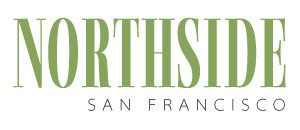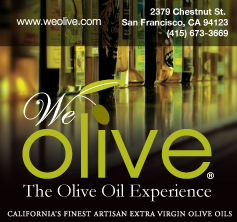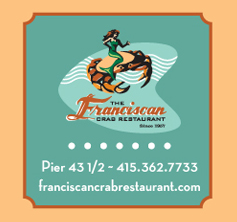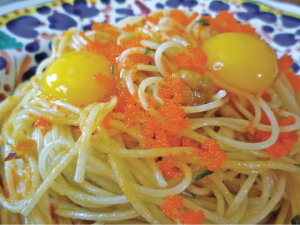
Pasta con ricci
For pasta con ricci you’ll need to go to a Japanese market for the ingredients, but it’s worth the trip. I visit Nijiya in Japantown (1737 Post Street, corner of Webster) several times a month for their unique ingredients, sushi-grade fish, and organic meats and eggs.
High quality, fresh-baked bread is key for two of these recipes. Before I hit Nijiya, I head to Andersen Bakery (next door, inside the Japantown mall), a hidden gem serving pastries, cakes (the strawberry shortcake is not to be missed), and some of the best bread in town. Selection varies, but they make wonderful pain de Campagne (country French with 5 percent rye), ciabatta (rustic hand-shaped Italian white bread), foccacia (soft olive oil bread), and a premium Pullman loaf (a fancy term for white sandwich bread with four square corners). Prices at Andersen are reasonable, and if you don’t want an entire loaf they also sell half loaves. The clerks will slice it for you, but I ask for my loaves whole so I can cut them to the desired thickness depending on the recipe.
You can also get most of these breads at other fine bakeries including the Italian French Baking Company (1501 Grant Avenue) and Liguria Bakery (1700 Stockton Street), both in North Beach; La Boulange Bakery (various locations in the Northside), and across town at Tartine Bakery in the Mission (600 Guerrero Street).
Soft-Boiled Egg Salad
Sandwich
Serves 2
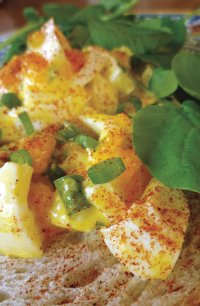
Soft-boiled egg salad sandwich
For the greens I use watercress, a member of the cabbage family that has pungent, peppery notes. You can find it at most supermarkets, but I get it “live” at Nijiya. Because it still has the roots attached, you can plant what you don’t use in a pot on your deck or in your garden – it likes dampness, so San Francisco weather is ideal. If you’re not an urban gardener, you can use the leftover watercress to make soup (I like it simply puréed with potatoes, chives, chicken broth, and milk). If you’re not a watercress fan, substitute mixed greens (young, tender baby greens work best). I serve this sandwich open-faced, but you can prepare it traditionally as well.
4 soft boiled eggs (see method below)
2 tablespoons mayonnaise (optional)
Generous pinch white pepper (you can use black pepper, but white pepper is milder)
Pinch of kosher salt
½ tablespoon fresh chives (you can also use the dark ends of a green onion); divided
1 teaspoon fresh lemon juice
2 slices pain de Campagne (or other good French or sourdough bread)
Dash of sweet paprika
1 cup watercress (or mixed greens), loosely packed
Put peeled eggs in a medium sized bowl. With a fork and butter knife, gently cut them into chunks using a slicing motion (do not smash the eggs like you would for a traditional egg salad sandwich).
Add mayonnaise, white pepper, salt, and half the chives. Fold together until well mixed. Add lemon juice and mix gently again.
Put slices of bread on dinner-sized plates, one slice per plate. Spoon half the egg salad mixture on each slice. Sprinkle with sweet paprika, remaining chives, and top with watercress.
Perfect soft-boiled eggs
Prepare an ice bath by filling a medium-sized bowl with ice and water. Fill a medium saucepan ¾ full of water. Bring to a boil, add a generous pinch of salt, and reduce to a simmer.
Pierce the bottom of each egg with an egg piercer (a push pin will also work) – this allows air to escape, which prevents cracking, and also allows sulfur to escape so you won’t get that unsightly greenish-grey ring around the yolk.
Using a large slotted spoon, carefully lower the eggs into the water. Set a timer for 7 minutes. Occasionally move the eggs around the pan so the yolks don’t settle to one side and the whites cook evenly.
After 7 minutes remove the eggs from the saucepan, and plunge immediately into the ice bath. (If you want your eggs softer, reduce cooking time to 5–6 minutes; for harder eggs increase cooking time to 8–9 minutes.)
Pasta Con Ricci
(Pasta with Sea Urchin)
Serves 4
I remember going with my grandfather to the Rhode Island coast while he dived for sea urchin. He would crack them open on the beach and scoop out the sweet, creamy roe (it’s actually the sea urchin’s gonads, but don’t let that scare you – it’s delicious). For dinner he would make pasta con ricci, a classic dish popular in his hometown of Palermo, Sicily. If you can get live sea urchins, the most dramatic presentation is the way my grandfather did it: cut the urchin in half, twist the pasta into the urchin, and serve it in its spiny vessel. When he had that Sicilian delicacy bottarga (tuna or mullet roe, sun-dried and cured in salt), he would shave a little on top.
For this recipe I am using fresh sea urchin (known as uni in Japanese) already removed from the spiny vessel. You can find bottarga at the Marina’s Lucca Deli (2021 Chestnut Street), but for this recipe I am substituting tobiko (flying fish roe), which has a delicate crunch and sweet, briny flavor that complements the urchin. I top the pasta with quail egg yolks to add an extra bit of creaminess. All of these ingredients are available at the Japanese market.
Tip: To separate eggs, gently move the egg from hand to hand, allowing the whites to fall between your fingers. Because quail eggs are small and the membranes are tough, I use a serrated knife to slice through the shell and membrane at the top of the egg and then gently slide the egg onto my fingers.
1 pound spaghetti (I prefer the thinner angel hair, but any long pasta will work)
Generous pinch kosher salt
4 tablespoons good quality extra virgin olive oil
4 cloves fresh garlic, roughly chopped
Pinch crushed red pepper flakes
2 tablespoons fresh Italian (flat leaf) parsley, roughly chopped; divided
1 tray fresh sea urchin
4 tablespoons fish roe (tobiko)
8 quail egg yolks
Bring a large pot of water to a boil over high heat. Add a generous pinch of kosher salt. Add the pasta and cook al dente (firm but not hard), stirring frequently to prevent sticking.
Meanwhile in a large skillet, heat the olive oil over medium heat. Add the garlic, reduce heat to low, and sauté until just golden brown (about 5 minutes). Stir in the crushed pepper flakes and half the parsley. Using tongs, add pasta and a splash of pasta water to the pan. Turn up heat to medium-low and toss gently until pasta is coated with sauce. Add the sea urchin and sauté with the pasta and sauce until the urchin is just warmed through (about 30 seconds).
Put the pasta into four bowls, using the tongs to twist the pasta into neatly swirled “haystacks.” Top each portion with 1 tablespoon of tobiko and 2 quail egg yolks. Just before eating, use a fork and spoon to mix the tobiko and quail egg yolks with the pasta. Garnish with remaining parsley.
Eggs in a Hole
Serves 4
This version is vegetarian, but you can dress it up any way you like. When we had guests, my mom would set the table with little bowls of goodness – crumbled bacon and sausage, grilled tomatoes and asparagus, fresh herbs and infused oils, thin slices of steak and chicken – and let us create our own masterpieces.
4 slices of bread, cut 1-inch thick
16 thin slices of good melting cheese like Gruyère or fontina
8 egg yolks
Salt and freshly ground
pepper to taste
Preheat oven to 350 degrees. Place bread on a baking sheet and toast for 1 to 2 minutes.
Using a serrated knife cut a rectangle big enough to snugly fit two egg yolks in each slice of bread. Use your fingers to press the rectangle down to create a well for the egg yolks. Place 4 slices of cheese on each slice of bread around the well, creating a flat “fence” (the top of the bread should be covered with cheese except for the indent, but cheese should not hang over the edges).
Slide two yolks into each well. Return to the 350-degree oven until the cheese is melted and bubbly and the yolks are warmed but still runny (2–3 minutes) or, if you prefer eggs more cooked, 4–6 minutes. Transfer to plates and serve as is or with toppings of your choice.
E-mail: susan@northsidesf.com
